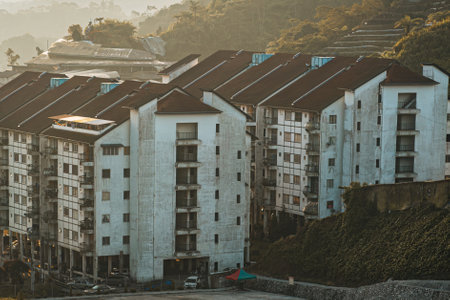Emergence of City Apartment Living in India
The rise of city apartment living marks a significant shift in the Indian real estate landscape, particularly among urban professionals, nuclear families, and students. In metros like Mumbai, Bengaluru, and Delhi NCR, as well as fast-growing tier-2 cities such as Pune, Lucknow, and Coimbatore, apartments have become synonymous with modern lifestyle aspirations. City-centric apartment complexes now offer a blend of contemporary design and convenience that resonates with a new generation seeking more than just a roof over their heads.
The allure of amenities such as 24/7 security, power backup, gyms, swimming pools, clubhouses, and landscaped gardens has made apartments highly desirable for upwardly mobile Indians. In contrast to traditional independent houses commonly found in small towns, city apartments provide not only safety but also a sense of community living—something increasingly valued by young families and single working professionals. These developments reflect India’s evolving urban culture where time-saving features, connectivity to business hubs, and access to social infrastructure are major priorities.
Moreover, for students and job seekers relocating from small towns to larger cities, apartment living offers flexibility through rental options and shared accommodations. The preference for managed spaces with maintenance support underlines the growing importance of hassle-free living in today’s fast-paced urban environment. As Indian cities expand vertically to accommodate rising populations and land scarcity, city apartments continue to symbolize ambition and the pursuit of an upgraded lifestyle.
2. Independent Houses in Small Towns: Tradition Meets Comfort
In India’s small towns, the preference for independent houses continues to hold strong, rooted deeply in cultural values and the unique social fabric of these communities. Unlike the high-rise apartments of metro cities, independent houses offer a blend of tradition, comfort, and practicality that resonates with many families. The joint family system, still prevalent across Tier II and III cities, makes such homes ideal for accommodating multiple generations under one roof. This arrangement nurtures close-knit ties and supports customary practices like shared meals and festivities.
Space remains a key consideration. With larger plots available at relatively affordable rates compared to urban centers, residents enjoy private gardens, courtyards, and even space for livestock or kitchen gardens—luxuries rarely found in city apartments. Privacy is another major draw; independent homes allow families to maintain their own routines without interference from neighbors or restrictive housing society rules.
The table below illustrates some distinctive features valued by small-town dwellers:
| Feature | Independent Houses | City Apartments |
|---|---|---|
| Living Space | Ample & Customizable | Limited & Predefined |
| Family Structure | Supports Extended Families | Mainly Nuclear Families |
| Community Ties | Strong Local Connections | Often Less Interaction |
| Outdoor Areas | Private Gardens/Yards | Shared/Common Spaces |
In terms of investment value, independent houses often appreciate over time due to land ownership—a crucial aspect in Indian culture where property is seen as a legacy asset passed down generations. Additionally, rituals and festivals are celebrated with greater freedom and space, reinforcing community bonds.
This enduring preference highlights how tradition meets comfort in small-town India, making independent houses not just a place to live but a symbol of stability, heritage, and social belonging.

3. Lifestyle Differences: Community Life vs Personal Space
When it comes to lifestyle, the choice between city apartment living and independent houses in India’s small towns goes beyond just a roof over one’s head—it shapes daily experiences, social interactions, and even personal routines.
Apartment Living: A Sense of Community and Convenience
Modern city apartments often bring together diverse families from different backgrounds, fostering a unique sense of community. Shared spaces such as clubhouses, gyms, gardens, and children’s play areas encourage residents to interact regularly, creating a vibrant social environment. Security is a major advantage; gated complexes with CCTV surveillance and 24/7 guards offer peace of mind for working professionals and families alike. Additionally, amenities like power backup, housekeeping, and maintenance services make urban living hassle-free—an attractive prospect for those with busy lifestyles or nuclear family setups.
Independent Houses: Embracing Autonomy and Local Bonds
In contrast, independent houses in small Indian towns offer spaciousness and autonomy that apartments often lack. Homeowners enjoy larger plots, private gardens, and the flexibility to modify their homes as per personal taste—a prized aspect in Indian culture where vastu-compliant renovations or festive decorations hold importance. The neighbourhood bonds here are deeply rooted; neighbours often become extended family members, sharing local traditions and celebrations together. While privacy is maximised, the absence of formal security systems means residents rely more on close-knit community vigilance and mutual trust.
Choosing Your Ideal Lifestyle
The decision ultimately hinges on individual preferences: city apartments promise convenience, security, and social interaction within a structured setting, whereas independent houses deliver freedom, space, and an authentic connection to local culture. Both living styles mirror evolving aspirations of Indian families—balancing modernity with tradition, collective living with personal freedom.
Trends Influencing Housing Choices
As India’s urban and semi-urban landscapes continue to evolve, the choice between city apartment living and independent houses in small towns is increasingly influenced by a variety of emerging trends. These factors are reshaping preferences, lifestyles, and investment decisions among Indian homebuyers.
Key Drivers Shaping Housing Decisions
| Trend | Impact on Buyer Preference |
|---|---|
| Rising Real Estate Values | Increasing property prices in major cities have made apartments more attractive due to affordability, while smaller towns still offer value-for-money independent homes. |
| Changing Job Markets | The shift of job opportunities towards tier-2 and tier-3 cities is driving demand for independent houses as professionals seek better work-life balance and proximity to family roots. |
| Aspirations for Modernity | Younger generations desire modern amenities, security, and lifestyle facilities found in city apartments, reflecting changing social aspirations. |
| Work-from-Home Shifts | The pandemic-induced remote work culture has led many families to prefer spacious independent houses in small towns, seeking larger living spaces and private environments. |
| Infrastructure Improvements | Enhanced connectivity, better roads, metro expansions, and digital infrastructure in smaller cities are closing the gap with metros, making both apartments and independent homes viable choices outside big cities. |
Understanding the Indian Context
In India, cultural nuances play a significant role in housing decisions. Traditionally, owning an independent house has been a symbol of status and permanence. However, with rising aspirations and exposure to global living standards—especially among millennials—there is a growing demand for city apartments featuring clubhouses, gyms, 24×7 security, and community living. At the same time, improved infrastructure in towns like Coimbatore, Indore, or Bhubaneswar makes independent villas or bungalows more attractive for those prioritising space and privacy. The interplay between these evolving trends is redefining what it means to own a home in modern India.
5. Financial Considerations: Investment and Long-term Value
When it comes to real estate decisions in India’s small towns, financial factors often weigh heavily on buyers’ minds. Let’s break down the key considerations—pricing trends, maintenance costs, rental yields, and resale potential—for both city apartments and independent houses, reflecting how Indian families balance aspirations, tradition, and long-term investment security.
Pricing Trends: Upfront Cost and Appreciation
City apartments in tier-2 and tier-3 towns generally come with a lower entry price compared to metropolitan areas, but they still tend to cost more per square foot than independent homes due to amenities and location advantages. Over recent years, apartment prices in growing towns like Indore or Coimbatore have shown steady appreciation as demand rises for gated communities and lifestyle upgrades. In contrast, independent houses may offer larger plot sizes at a comparable price point, especially on the town outskirts; however, their appreciation rates can be slower unless the area undergoes significant infrastructure development.
Maintenance Costs: Shared vs Personal Responsibility
Monthly maintenance is a crucial factor for many Indian buyers. Apartments typically require residents to pay monthly society fees covering security, amenities upkeep, and common utilities—an attractive proposition for those seeking hassle-free living. Independent house owners shoulder the full burden of repairs, water supply management, security arrangements, and landscaping. For joint families or tradition-focused buyers used to managing their own space, this control is valued; younger professionals might prefer the convenience of shared responsibility that apartments provide.
Rental Yields: Income Potential
Apartments in small cities often fetch higher rental yields compared to independent homes because of their modern amenities and safety features that appeal to working professionals and nuclear families. Proximity to educational institutions or commercial hubs further increases rental demand. Independent houses may attract tenants looking for more privacy or larger family spaces but can face longer vacancy periods and lower per-square-foot returns.
Resale Potential: Liquidity and Demand
The resale market in India’s smaller cities is evolving. Apartments enjoy faster liquidity thanks to organized marketing by developers and growing preference among urbanized buyers for ready-to-move-in properties. However, older apartments may face depreciation if building quality or amenities deteriorate over time. Independent homes retain value through land ownership—a critical consideration in Indian culture where “zameen” (land) is seen as an asset that never loses worth—but finding buyers who match one’s valuation expectations can take time.
Balancing Aspiration, Tradition & Security
Indian homebuyers are increasingly pragmatic. While tradition nudges many toward independent homes for their perceived legacy value and freedom of customization, aspiration drives younger buyers towards city apartments offering modern comforts and community living. Investment security remains a top priority; buyers carefully assess not just current costs but also long-term returns—seeking properties that blend emotional fulfillment with sound financial prospects in India’s dynamic small-town landscape.
6. Cultural and Generational Perspectives
One of the most compelling aspects shaping the debate between city apartment living and independent houses in Indian small towns is the interplay of cultural values and generational preferences. Traditionally, Indian families have cherished the idea of owning a plot of land and building an independent house—a symbol of stability, legacy, and personal freedom. Elders often associate independent homes with ancestral pride, privacy, and the ability to host extended family gatherings during festivals or special occasions.
However, with changing times, there has been a visible generational shift. Millennials and Gen Z, influenced by urbanisation and global trends, are increasingly drawn towards city apartments for their convenience, security features, and community-driven amenities. For young professionals and nuclear families, apartments represent modernity, efficient use of space, and low maintenance living. The sense of community in apartment complexes—with clubs, gyms, swimming pools, and children’s play areas—caters perfectly to their lifestyle aspirations.
Balancing Tradition with Modern Aspirations
The decision-making process within Indian families often involves balancing the elders’ desire for tradition with the younger generation’s appetite for contemporary comfort. While grandparents may emphasise the emotional connection to land and open spaces in independent houses, younger members might prioritise access to better infrastructure, proximity to workplaces, and vibrant social interactions that city apartments offer.
Joint Family vs Nuclear Family Dynamics
Family structure plays a pivotal role as well. Joint families typically prefer independent houses for their spacious layouts and potential for expansion as the family grows. In contrast, nuclear families opt for apartments that support fast-paced urban lifestyles and reduce day-to-day responsibilities like security and property upkeep.
Cultural Nuances & Future Trends
Cultural nuances—like celebrating Diwali with fireworks in open courtyards or maintaining a kitchen garden—still pull many towards independent homes. Yet, the aspirational value attached to ‘apartment address’ in emerging small towns is on the rise. This tug-of-war between heritage and ambition is what makes every family’s choice unique, reflecting India’s evolving socio-cultural tapestry.
7. Future Outlook: Blending Modernity and Tradition
As India’s real estate landscape continues to evolve, the distinction between city apartment living and independent houses in small towns is becoming increasingly nuanced. With rapid urbanisation spreading into tier 2 and tier 3 cities, residents are seeking a harmonious blend of modern amenities and traditional values in their homes. Upcoming trends indicate that smart home integration is no longer limited to metropolitan apartments; even independent houses in small towns are adopting IoT devices, security systems, and energy-efficient appliances, reflecting aspirations for convenience and safety across demographics.
Eco-friendly building practices are gaining traction nationwide, with both apartments and standalone homes incorporating rainwater harvesting, solar panels, and sustainable materials. Developers are responding to the heightened environmental consciousness among Indian homeowners by designing projects that balance luxury with responsibility—be it green rooftops in high-rise complexes or organic vegetable gardens in private backyards.
Changing aspirations are also evident in lifestyle choices. Young professionals in smaller cities are increasingly attracted to apartment complexes offering clubhouse facilities, co-working spaces, and community events reminiscent of urban living. Conversely, city dwellers who relocate to small towns often seek independent houses that allow for greater customisation, open spaces, and the preservation of joint family traditions.
Looking ahead, the boundaries between apartments and independent homes may blur further as hybrid developments emerge—think gated communities with low-rise villa clusters alongside mid-rise apartment towers. These models aim to combine the privacy and space of an independent house with the shared amenities and security of apartment life.
Ultimately, the future of housing in urban and small-town India will be shaped by a desire for comfort, technology adoption, sustainability, and cultural continuity. Whether one opts for an apartment in a bustling city or an independent home in a tranquil town, the focus will remain on creating living spaces that reflect both modern aspirations and timeless Indian traditions.


